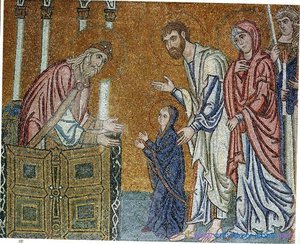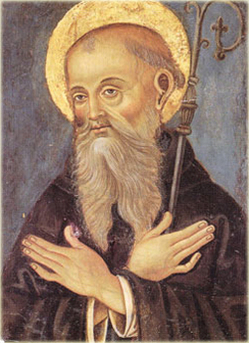 The feast of King Saint Henry (972-1024) always brings with it a keen remembrance of the commitment one makes as an Benedictine Oblate: seeking God unreservedly. The offering of oneself to God as a Benedictine oblate is a singular grace to take the gift of one’s humanity seriously as God has given it with the express desire to totally adore Him who makes us.
The feast of King Saint Henry (972-1024) always brings with it a keen remembrance of the commitment one makes as an Benedictine Oblate: seeking God unreservedly. The offering of oneself to God as a Benedictine oblate is a singular grace to take the gift of one’s humanity seriously as God has given it with the express desire to totally adore Him who makes us.
Category: Benedictine Oblate
Presentation of the Blessed Virgin Mary and Benedictine Oblation
 As we Venerate the glorious memory of the most holy Virgin Mary, grant, we pray, O Lord, through her intercession, that we, too, may merit to receive from the fullness of your grace.
As we Venerate the glorious memory of the most holy Virgin Mary, grant, we pray, O Lord, through her intercession, that we, too, may merit to receive from the fullness of your grace.
On retreat …
This weekend is the 71 st annual retreat of the New York area Benedictine Oblates of the Archabbey of Saint Meinrad. The retreat is being held at Mariandale Retreat House, Ossining, NY with the retreat master being Brother John Mark Falkenheim, OSB. His theme is “Grace and Human Nature in the Rule of Saint Benedict.”
Pray for the 35 Oblates.
Attention in Prayer
This morning on my train ride into the City, I was reading a monograph by Archabbot Lambert Reilly, OSB, the emeritus archabbot of St Meinrad Archabbey, “Prayer: A Conversation with God.” I recommend it. Why? Because I need to be reminded that prayer is not a monologue but a dialogue; it is the heart speaking to the Heart. I also have to remember it is not about me exclusively but about Him who is greater than I.
Saint Henry: Benedictine Oblate and patron of sovereign leaders
 The Church recalls the witness of an emperor and a Benedictine Oblate, Saint Henry (972-1024), Duke of Bavaria. Henry was crowned king in Rome by Pope Benedict VIII in 1014. It is said that Henry was assisted by the saints throughout his life but especially at Mass when he was anointed king. He was an insightful leader, lay man who had concern for the discipline of the Church and who had love for the Benedictine monastic life. He was a supporter of Cluny’s reforms. It was through Saint Henry that the King of Hungary and later saint, Stephen, met Christ and was baptized.
The Church recalls the witness of an emperor and a Benedictine Oblate, Saint Henry (972-1024), Duke of Bavaria. Henry was crowned king in Rome by Pope Benedict VIII in 1014. It is said that Henry was assisted by the saints throughout his life but especially at Mass when he was anointed king. He was an insightful leader, lay man who had concern for the discipline of the Church and who had love for the Benedictine monastic life. He was a supporter of Cluny’s reforms. It was through Saint Henry that the King of Hungary and later saint, Stephen, met Christ and was baptized.
Saint Henry: emperor, husband and Benedictine Oblate
Today’s saint, Henry II, is one of the few monarchs admitted to the canon of saints. Emperors along with civil and canon lawyers don’t seem to be too plentiful among the communion of saints. Henry was in fact an emperor, a husband and a Benedictine oblate. Throughout his life Henry devoted himself to the evangelization of peoples, the support of the Church (materially and spiritually), and is known to have attended to his spiritual life by being faithful to lectio divina, praying the Divine Office and the sacred Liturgy, and doing works of mercy and charity for the poor and marginalized. He is reported to have lived very chastely with his wife. Also important for us here is the fact that as king, Henry followed the Rule of Saint Benedict with a degree of seriousness that was rather unheard of, even among the monks and nuns. As Saint Benedict lived his earthly life and enjoined on his followers a sense of attentiveness to the reality of the final judgment, Henry conformed his life to the same: as Benedict had a concern for the welfare of brothers, he also instilled in them a heightened sense of Christ’s final judgment, and so did Henry. Do we?
What is a Benedictine Oblate?
An Oblate of Saint Benedict is a Christian individual (lay people and diocesan priests) who is associated with a particular
 Benedictine monastery, usually one that is close to where one lives, in order to enrich his or her Christian way of life. An Oblate forms and sustains a spiritual bond with the monastery where the oblation is made. So, the hope is that those making an oblation actually share in a spiritual union that is based in friendship with a particular monastic community. Bonded in prayer, love and commitment, Oblates are partners in the prayer and works of the monastery and with the professed monks, nuns and oblates search for God together with the goal of arriving at our destiny: the Beatific Vision, God.
Benedictine monastery, usually one that is close to where one lives, in order to enrich his or her Christian way of life. An Oblate forms and sustains a spiritual bond with the monastery where the oblation is made. So, the hope is that those making an oblation actually share in a spiritual union that is based in friendship with a particular monastic community. Bonded in prayer, love and commitment, Oblates are partners in the prayer and works of the monastery and with the professed monks, nuns and oblates search for God together with the goal of arriving at our destiny: the Beatific Vision, God.
Oblates are most often Catholics, but practicing members of the Christian ecclesial communities are also welcome to be Oblates. But for Catholic Oblates, there is a crucial connection between the Holy Eucharist and sacred Scripture, devotion to the Blessed Virgin Mary and faithfulness to the Church teaching. The hope is that an Oblate conforms his or her life according the Gospel, the Rule of Saint Benedict and the constitutions (customs) of a particular family of monks or nuns, e.g., the American-Cassinese Congregation, the Swiss-American Congregation or the English Benedictine Congregation or whatever monastic family in which you make your oblation. An example could be that as monks take a new name upon entering the monastic life so too do some Oblates take on an “oblate name” demonstrating a change of heart and mind. This name is not for legal use, mind you.
Some simple duties of a Benedictine Oblate are:
-daily praying of Lauds and Vespers (and praying the other Hours are encouraged)
-daily Lectio Divina
-daily reading of a chapter of the Rule of Saint Benedict (no more than 3-4 paragraphs)
-frequent reception of the sacraments of Holy Communion and Confession (according to your Church)
-keep some portion of the day in silence as possible
-be committed to ongoing spiritual, intellectual and human formation
-if possible, see a spiritual director
-keep an awareness of the Trinitarian life in front of you, that in all things God may be glorified
-keep the bond of friendship with the monastery of oblation in the unity of prayer and other support
-and perhaps doing some charitable work as possible.
As a Christian the Oblate seeks God by striving to become a saint in his or her daily life; this is accomplished by integrating a life of prayer and work because they manifest Christ’s presence to society.
Available websites:
- The Rule of Saint Benedict
- General Information on Benedictine Oblates
- International Benedictine Oblates
- The Oblate Forum
- Resources from the Archabbey of St Meinrad for Oblates
- The Oblate Newsletter from Saint Vincent Archabbey
- The Oblate Newsletter from Saint John’s Abbey
A good example of Oblate Statutes comes from the Monastery of the Glorious Cross (Branford, CT). The former chaplain wrote the statutes with the sisters.
Saint Benedict and Saint Scholastica, pray for us!
Saint Maurus and Saint Placid, pray for us!
Saint Henry and Saint Frances of Rome, pray for us!
Novena to St. Benedict
 O Glorious St. Benedict, sublime model of all virtues, pure vessel of God’s grace! Behold me, humbly kneeling at thy feet. I implore thy loving heart to pray for me before the throne of God. To thee I have recourse in all the dangers which daily surround me. Shield me against my enemies, inspire me to imitate thee in all things. May thy blessings be with me always, so that I may shun whatever God forbids and avoid the occasions of sin.
O Glorious St. Benedict, sublime model of all virtues, pure vessel of God’s grace! Behold me, humbly kneeling at thy feet. I implore thy loving heart to pray for me before the throne of God. To thee I have recourse in all the dangers which daily surround me. Shield me against my enemies, inspire me to imitate thee in all things. May thy blessings be with me always, so that I may shun whatever God forbids and avoid the occasions of sin.
Graciously obtain for me from God those favors and graces of which I stand so much in need, in the trials, miseries and afflictions of life. Thy heart was always so full of love, compassion, and mercy towards those who were afflicted or troubled in any way. Thou didst never dismiss without consolation and assistance anyone who had recourse to thee. I therefore invoke thy powerful intercession in the confident hope that thou will hear my prayers and obtain for me the special grace and favor I so earnestly implore (mention it), if it be for the greater glory of God and the welfare of my soul.
Pope Benedict XVI speaks at the monastery of the Benedictine Oblate Sisters of St. Frances of Rome, Tor de’ Specchi
This is a rather important talk Pope Benedict XVI gave while visiting the Oblates of Saint Frances of Rome. Every pope since the 16th century has visited this monastery. Pope John Paul was the last 25 years ago.
Dear Oblate Sisters,
 After my visit to the nearby Municipal Hall on the Capitoline Hill, I come with great joy to meet you at this historic Monastery of Santa Francesca Romana, while you are still celebrating the fourth centenary of her canonization on 29 May 1608. Moreover, the Feast of this great Saint occurs this very day, commemorating the date of her birth in Heaven. I am therefore particularly grateful to the Lord to be able to pay this tribute to the “most Roman of women Saints”, in felicitous continuity with the meeting I have just had with the Administrators at the municipal headquarters. As I address my cordial greeting to your community, and in particular to the President, Mother Maria Camilla Rea whom I thank for her courteous words expressing your common sentiments I also extend my greeting to Auxiliary Bishop Ernesto Mandara, to the students who live here and to everyone present.
After my visit to the nearby Municipal Hall on the Capitoline Hill, I come with great joy to meet you at this historic Monastery of Santa Francesca Romana, while you are still celebrating the fourth centenary of her canonization on 29 May 1608. Moreover, the Feast of this great Saint occurs this very day, commemorating the date of her birth in Heaven. I am therefore particularly grateful to the Lord to be able to pay this tribute to the “most Roman of women Saints”, in felicitous continuity with the meeting I have just had with the Administrators at the municipal headquarters. As I address my cordial greeting to your community, and in particular to the President, Mother Maria Camilla Rea whom I thank for her courteous words expressing your common sentiments I also extend my greeting to Auxiliary Bishop Ernesto Mandara, to the students who live here and to everyone present.
As you know, together with my collaborators in the Roman Curia, I have just completed the Spiritual Exercises which coincided with the first week of Lent. In these days I have experienced once again how indispensable silence and prayer are. And I also thought of St
Your monastery is located in the heart of the city. How is it possible not to see in this, as it were, the symbol of the need to bring the spiritual dimension back to the centre of civil coexistence, to give full meaning to the many activities of the human being? Precisely in this perspective your community, together with all other communities of contemplative life, is called to be a sort of spiritual “lung” of society, so that all that is to be done, all that happens in a city, does not lack a spiritual “breath”, the reference to God and his saving plan. This is the service that is carried out in particular by monasteries, places of silence and meditation on the divine word, places where there is constant concern to keep the earth open to Heaven. Then your monastery has its own special feature which naturally reflects the charism of St
 In our day too, Rome needs women and of course also men but here I wish to emphasize the feminine dimension women, as I was saying, who belong wholly to God and wholly to their neighbour; women who are capable of recollection and of generous and discreet service; women who know how to obey their Pastors but also how to support them and encourage them with their suggestions, developed in conversation with Christ and in first-hand experience in the area of charity, assistance to the sick, to the marginalized, to minors in difficulty. This is the gift of a motherhood that is one with religious self-gift, after the model of Mary Most Holy. Let us think of the mystery of the Visitation. Immediately after conceiving the Word of God in her heart and in her flesh, Mary set out to go and help her elderly kinswoman Elizabeth. Mary’s heart is the cloister where the Word continues to speak in silence, and at the same time it is the crucible of a charity that is conducive to courageous gestures, as well as to a persevering and hidden sharing.
In our day too, Rome needs women and of course also men but here I wish to emphasize the feminine dimension women, as I was saying, who belong wholly to God and wholly to their neighbour; women who are capable of recollection and of generous and discreet service; women who know how to obey their Pastors but also how to support them and encourage them with their suggestions, developed in conversation with Christ and in first-hand experience in the area of charity, assistance to the sick, to the marginalized, to minors in difficulty. This is the gift of a motherhood that is one with religious self-gift, after the model of Mary Most Holy. Let us think of the mystery of the Visitation. Immediately after conceiving the Word of God in her heart and in her flesh, Mary set out to go and help her elderly kinswoman Elizabeth. Mary’s heart is the cloister where the Word continues to speak in silence, and at the same time it is the crucible of a charity that is conducive to courageous gestures, as well as to a persevering and hidden sharing.
Dear Sisters, thank you for the prayers with which you always accompany the ministry of the Successor of Peter and thank you for your invaluable presence in the heart of
Pope Benedict visits Saint Frances of Rome’s monastery
The Pope’s visit to the monastery founded by Saint
 The spiritual dimension of life must be brought back to the centre of civil coexistence. Benedict XVI said this during his visit to the historical monastery of Saint Francesca Romana in Tor de Specchi near the Campidoglio.
The spiritual dimension of life must be brought back to the centre of civil coexistence. Benedict XVI said this during his visit to the historical monastery of Saint Francesca Romana in Tor de Specchi near the Campidoglio.
The Oblate sisters’ community of contemplative life, in close connection with the Olivetani monks, is called to be society’s “spiritual lung”, in order maintain the reference to God and to His plan of salvation. The Pope noted that the convent, which was founded by St. Francesca Romana, is characterized by a singular equilibrium between religious and secular life.
Contact the oblates:
Monastero delle Oblate di Santa Francesca Romana (Tor de’ Specchi)
Via
Roma, Italia
Tel. 011.39.06.679.3565
e-mail: oblate@tordespecchi.it


